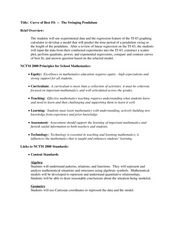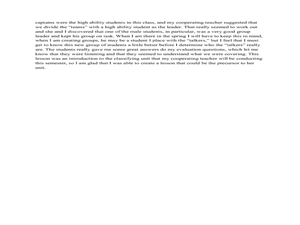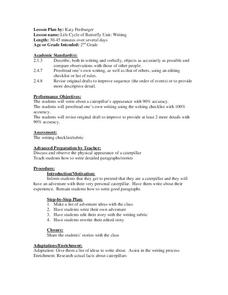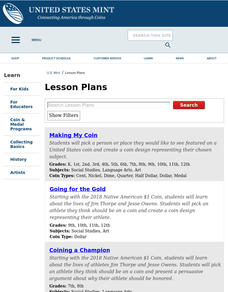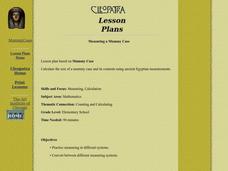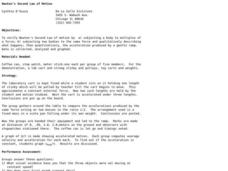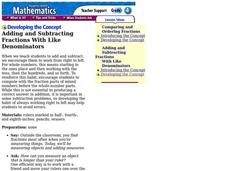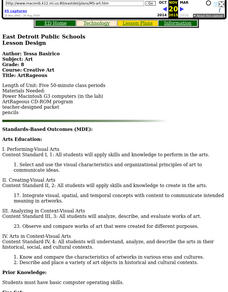Curated OER
Addition and Subtraction word problems
In this word problems instructional activity, students solve addition, subtraction, money, decimals, and percentage word problems. Students solve 47 problems total.
Curated OER
Distances to Stars
Students explore the idea of parallax. In this astronomy instructional activity, students study the distances of stars. They investigate how parallax can be used to determine these distances.
Curated OER
The Swinging Pendulum
Students observe a pendulum and graph their observation. In this algebra lesson, students use the TI calcualtor to graph the motion the pendulum makes. They analyze the graph and make predictions.
Curated OER
Earth
Fourth graders have a spatial awareness of the plants by orally discussing what they saw after they stepped out the model of the solar system. They recognize the similarities and differences between Earth and the other planets by being...
Curated OER
Classifying the Class
Fifth graders create dichotomous keys to create classifications of students in the classroom by writing instructions. In this classifications lesson plan, 5th graders learn how dichotomous keys are used in science observations.
Curated OER
Life Cycle of Butterfly
Second graders investigate life cycles of insects by writing a story. In this butterfly life lesson plan, 2nd graders create a checklist of the many steps a caterpillar takes before growing wings and flying. Students utilize...
Curated OER
Sorting Buttons
Students study sorting. In this classification instructional activity, students sort buttons into groups based on a common characteristic and draw two pictures illustrating the different groups.
Curated OER
The Shadow Knows - Measuring A Telephone Pole
Third graders attempt to determine the height of a telephone pole or tree without climbing to the top.
Curated OER
How Tall in the Fall?
First graders use nonstandard measurement to measure. After reading Inch by Inch, 1st graders pair measure leaves that they have collected. They glue their leaves onto tag board to make a display.
Curated OER
A World Of Matter
First graders complete a variety of experiments with solids, liquids and gases. They read books about matter, identify the characteristics of solids, liquids and gases and the sort and classify a variety of matter. Students make...
Curated OER
Odd Is In
Pupils play a game with coins and then use reasoning skills to develop a strategy for winning the game.
Curated OER
Easy Does It
Students discover how inclined planes make work easier as they make mathematical predictions and prove their predictions through experiments.
Curated OER
Calculate It
Fourth graders find the area and perimeters of squares and rectangles using a calculator to check their multiplication. They use the appropriate formulas to find the area and perimeter of the given geometric shapes.
Curated OER
Measuring a Mummy Case
Students calculate the size of a mummy case and its contents using ancient Egyptian measurements.
Curated OER
Tangram Perimeters
Students work together to make figures out of tangram squares. In groups, they calculate the measurements they need and apply the Pythagorean Theorem. They complete a worksheet solving equations using the theorem and review their answers.
Curated OER
"How Do You Measure Up?"
Fourth graders explore basic measurements by analyzing their own bodies. In this human anatomy activity, 4th graders identify the units used to measure a human body such as centimeters, inches, ounces and pounds. Students complete a...
Curated OER
Fruit Seeds
Second graders use fruit to conduct an observation experiment. They use the skills of observation to write down different facts about three different fruits looking at the outside and inside contents. Students explain two things they...
Curated OER
Newton's Second Law of Motion
Sixth graders study Newton's second law of motion and verify it. In this force and motion lesson students complete a lab activity and collect data, analyze it and graph it.
Curated OER
Properties of Fractals
Students build a working definition of regular fractal, look carefully at the concepts of dimension and scale, and are introduced to logarithms. They solve simple exponential equations for the exponent both by trial and error and using...
Curated OER
Angles: Angles, Angles, Everywhere
Students estimate and accurately measure the size of angles communicate with the appropriate geometric terms and symbols to describe and name angles, lines, line segments, rays
Curated OER
Properties of Fractals
Students build a working definition of a regular fractal, they measure the concepts of dimensions and scale, they explore the concept of a logarithm and they attempt to solve simple exponential equations for the exponent both by trial...
Curated OER
Adding and Subtracting Fractions with Like Denominators
Young scholars add or subtract fraction parts of mixed numbers before adding or subtracting the whole number parts. In this fractions lesson, students learn to use a ruler to help them add and subtract fractions with like denominators.
Curated OER
Art Rageous
Eighth graders research and investigate the following topics: color, light, perspective, composition, and artists' styles and lives. A class discussion of the different topics follows.


